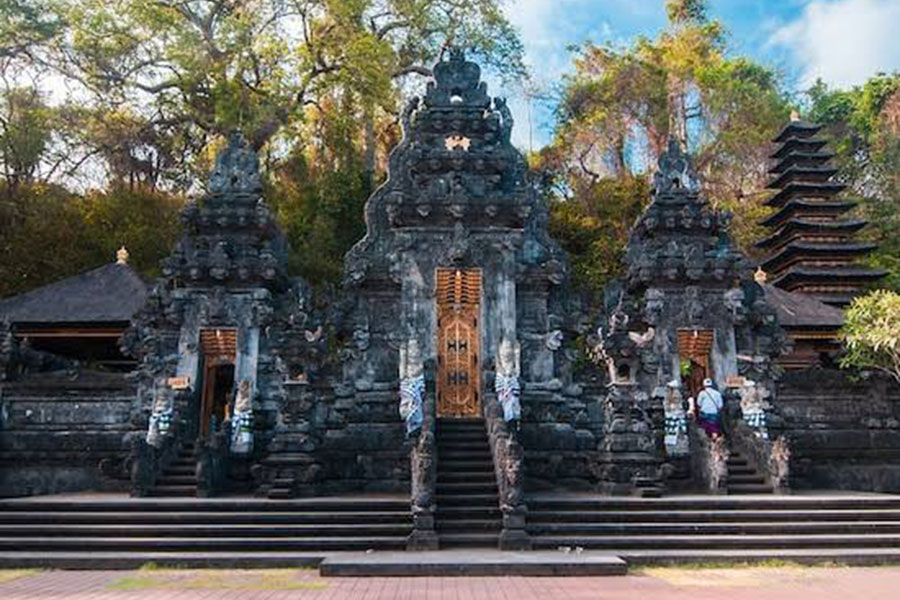BALI GOA LAWAH TEMPLE
BALI GOA LAWAH TEMPLE IS A TEMPLE WITH A NATURE CAVE DWELT BY THOUSANDS OF TAIL BAT

Goa Lawah Temple, also known as Bat Cave Temple, is one of Bali’s popular tourist destinations located on the edge of a hill and is often referred to as the middle hill coral. The cave is located in Pasinggahan Village, Dawan District, Klungkung Regency, in the eastern part of Bali. To the north of Gua Lawah Temple is a natural cave inhabited by thousands of bats. The main road from Klungkung to Amlapura also passes in front of this temple. The beauty of this cave is combined with a mesmerizing beach with black sand along the shoreline. Goa Lawah is one of the Klungkung places of interest and is an interesting tourist destination with its own uniqueness, so it is visited by many tourists exploring the eastern part of Bali. Its strategic location makes Goa Lawah a must-visit when vacationing on the eastern side of Bali, especially since it is close to the beach.
If you visit Goa Lawah Temple, here’s what you need to know:
- Location of Goa Lawah Temple
- The Uniqueness of Goa Lawah
- Bats in the Ecosystem
- History of Goa Lawah Temple
- Goa Lawah is Head of Basuki Dragon
- Goa Lawah for Worships God of Ocean
- Geography Goa Lawah Temple
- Facilities at Goa Lawah Temple
- Tour to Goa Lawah Temple
Location of Goa Lawah Temple
Goa Lawah Temple is located in Dawan Village, Klungkung Regency. From Denpasar, the journey to get there takes about an hour, following the main road to Karangasem. As you head towards Karangasem, you will pass this temple, which is located on the beach with beautiful, clear water, adding to its appeal. If you are interested in visiting this place, please contact us at Bali Exotic Tour, and we will provide a transfer to see this unique Goa Lawah Temple. There, you can see thousands of bats resting in the mouth of the cave during the day, and they come out when night falls. With the help of experienced drivers, the trip to Goa Lawah Temple will be a wonderful experience.
The Uniqueness of Goa Lawah
The uniqueness of Goa Lawah Temple lies in the presence of a group of bats that inhabit the cave passage there. The bats reside in an area that is considered sacred, and it is important not to disturb them as they are protected by local customary rules. It is strictly forbidden to hunt or capture these bats, as they are considered sacred creatures that guard the sanctity of Goa Lawah Temple. The sound of this nocturnal animal colony is an interesting phenomenon that can be enjoyed by visitors. In addition, the presence of bat reliefs on one of the temple gates, which separates the central courtyard (jaba tengah) from the inner courtyard (jeroan) of the temple, symbolizes that bats have a special position in this place. These nocturnal animals are nocturnal and start coming out of the cave in the afternoon. They come out in turns, and not all come out at the same time, so some wait their turn. Imagine if all the bats came out at the same time. Surely the surrounding area would be filled with dazzling clouds of bats.
Bats in the Ecosystem
So far, there has never been an incident between bats and residents around Goa Lawah Temple. In addition to bats, there are also snakes in the cave that have a sacred status and help control the bat population in the Goa Lawah Temple area. These snakes are also considered important to the sanctity of this place. The type of bats present here are fruit eaters, and they usually do not move away from their nests when they go foraging at night. Although the cave at Goa Lawah Temple has never been thoroughly explored, there is a legend that it can be connected to Besakih Temple. The role of bats here is very important as seed dispersers, insect predators, and indirect pollinators. They help regulate and maintain the balance of the ecosystem around them. Their presence is crucial, and losing any of these roles can disrupt the balance of nature. Information on the role of bats in ecosystems, their ranges, habitats, and rarity status is presented in this book for consideration in land management that prioritizes conservation aspects.
History of Goa Lawah Temple
According to the Dwi Jendra Tattwa papyrus, the original name of Goa Lawah was Goa Lelawah, a name given by Danghyang Nirartha (a Hindu priest who spread the teachings of Hinduism in Bali) when he stopped here during his Tirtha Yatra journey. At that time, he came across a cave where many bats were hanging, and their continuous singing-like sounds added to the beauty of the cave. Hence, the cave is known as Goa Lawah, or Bat Cave. On top of this cave, fragrant flowering trees grow that soothe Danghyang Nirartha’s heart, so he decided to spend the night here. From inside the cave, we can see the beauty of the beach with the blue ocean and Nusa Penida Island in the distance. Goa Lawah consists of two words: “Lawah” which means cave, and “Lawah” which means bat cave, considering that this cave is inhabited by thousands of bats at the mouth of the cave, which is also a Khayangan Jagat temple. Goa Lawah Temple is a sacred and mesmerizing place with a blend of sea and mountain (linga-yoni). In addition to the cave inhabited by bats, at the mouth of the cave there are several palinggih Stana Para Dewa. On the temple grounds, there are also several Meru and other stupas. MPU Kuturan came to Bali in the 10th century, during the reign of King Airlangga in East Java (1019-1042). At that time, he found many religious sects in Bali, and to unite them, he developed the concept of Tri Murti. MPU Kuturan also taught the creation of Three Pakraman Temples in every village in Bali and confirmed the existence of Goa Lawah Temple as one of the heavens of Jagat.
Goa Lawah is Head of Basuki Dragon
According to folklore, Goa Lawah has a very close relationship with Besakih Temple on the slopes of Mount Agung, which is the largest temple on Bali Island and also the mother temple in Bali. According to Lontar Prekempa, Goa Lawah is a representation of the head of Naga Basuki, while Goa Rajah in the Besakih complex is the tail. In Hindu mythology, it is explained that Naga Basuki is one of the three dragons sent to earth to save humanity. Naga Basuki symbolizes the cycle of natural balance, in which sea water evaporates, then descends to earth as rain on land, including mountains, and finally returns to the sea. This concept of natural balance is strongly associated with the existence of Goa Lawah, which makes it a center of worship for Bhatara Tengahing Segara, who is a representation of God in the form of oceanic providence, as well as the worship of Sang Hyang Naga Basuki.
Goa Lawah for Worships God of Ocean
In the concept of Balinese padma bhuana, Goa Lawah Temple is in the southeast position. The place of worship here is Ida Sang Hyang Widhi Wasa in the form of Dewa Maheswara. Although in the temple history books it is mentioned that Goa Lawah Temple was made to worship Batara Tengahing Segara, who is considered the ruler of the ocean, the belief circulating in the community states that the cave in Goa Lawah Temple can penetrate Besakih Temple. In the chronicles, it is mentioned that a prince from the kingdom of Mengwi was tested by Dalem Gelgel to enter the cave in Goa Lawah. The prince managed to penetrate Besakih Temple but was deaf. As a result of the test, the prince was named I Gusti Agung Ketut Besakih. This story shows that Goa Lawah is a place of worship for the mountain and the sea. Therefore, Hindus often use Goa Lawah Temple as a place to teach, or nyegara gunung. Here, the two elements meet to create a harmonious life: the mountain (Mount Agung) symbolizes land, and the sea (Indian Ocean) symbolizes water.
Geography Goa Lawah Temple
Goa Lawah Temple was built by applying the Tri Mandala concept system, which involves three basic courtyards, to the temple structure. This concept is commonly used in most temples in Bali and is believed to bring peace, prosperity, and well-being. Goa Lawah Temple itself is organized into five strata within the Tri Mandala concept.
- The first strata of Goa Lawah Temple include Goa Lawah itself, with the space inside the cave as the main or core area. The row of pelinggih (sacred buildings) inside the cave serves as the main madyaning, while the cave entrance area acts as the main nistaning.
- The second strata of Goa Lawah Temple consist of the temple innards with the natar puja as the main part, while the madyaning madya consists of pelinggihs. In addition, there are also bale piyasan and bale banten, which are part of nistaning madya.
- The third strata of Goa Lawah Temple are located outside the Kori Agung but still within the Candi Bentar area, called jaba madya. This main part of the kanista includes a row of complementary and sacred buildings. Madyaning Kanista is represented by the Central Jaba Mandala, while Nistaning Kanista consists of Bale Bengong, Bale Kulkul, and Bale Orderekan.
- The fourth strata of Goa Lawah Temple are located on the side of the jaba outside the bentar temple on the north side of the road. On the south side, there is a guardianship monument. On the west side, there is a wantilan paseban, and on the east side, there is a pewaregan with bale paebatan.
- The fifth strata of Goa Lawah Temple are located on the beach as a worship mandala. Here, the main mandala points south, with the madyaning mandala being a pesanekan building and a parking lot on the side of the road that serves as a canopy for the mandala.
Facilities at Goa Lawah Temple
The facilities at Goa Lawah Temple are very complete and support tourism here. The large parking lot makes it easy for visitors who come by car or motorcycle because they don’t have to worry about a lack of parking space. Around this area, there are also stalls selling food and drinks, similar to those on the beach. Clean toilets are also available for visitors’ use, and there are comfortable resting areas for those who want to relax after a long trip. In addition, there are souvenir sellers that provide souvenirs that can be purchased as gifts. These complete facilities provide comfort and convenience for visitors who want to visit Goa Lawah Temple. So, there is no need to worry when visiting here. Come and enjoy the uniqueness and stunning beauty of Goa Lawah Beach.
Tour to Goa Lawah Temple
If you are interested in visiting Goa Lawah Temple, we have a tour package that might interest you. This tour package not only visits the beauty and uniqueness of Goa Lawah Temple but also other interesting attractions in the eastern part of Bali Island. You can see the details here: East Bali Tour. This package offers affordable prices and guarantees satisfactory service, so your trip will be more memorable. Goa Lawah Temple is an ideal tourist destination to understand the traditional customs and ceremonies on the island of Bali. We from Bali Exotic Tour are committed to providing the best service to make your vacation an unforgettable experience. So, don’t hesitate anymore. Contact us immediately and enjoy the uniqueness of Goa Lawah Temple and the beauty of Bali Island during your vacation.

